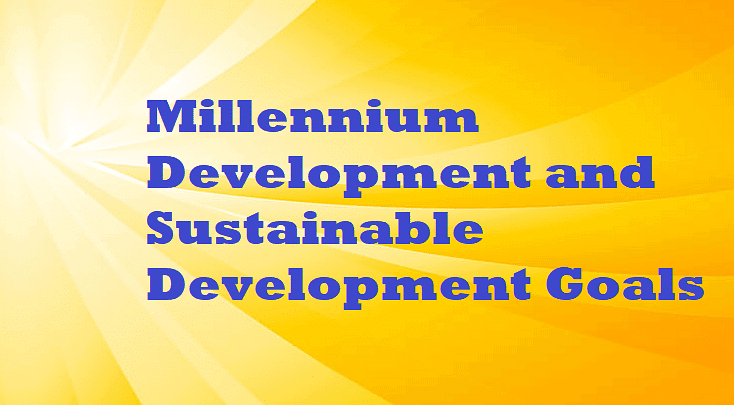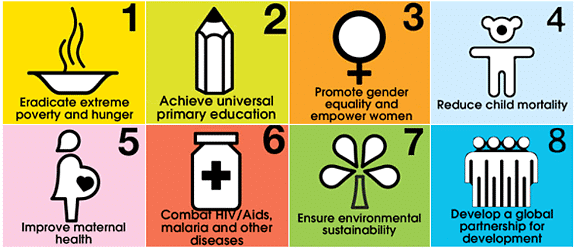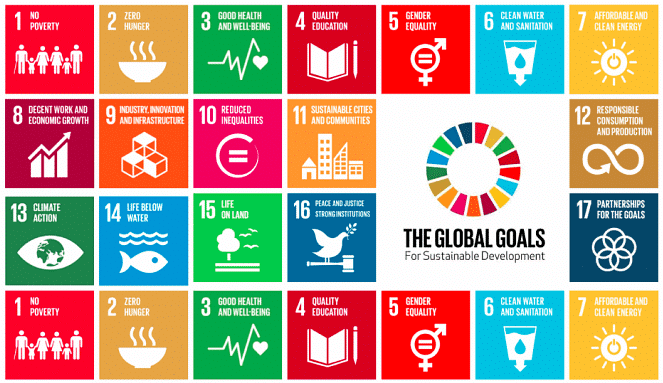Millennium Development and Sustainable Development Goals - People, Development and Environment Notes
| Table of contents |

|
| Introduction |

|
| Millennium Development Goals (MDGs) |

|
| The 17 Sustainable Development Goals |

|
| UNDP Strategic Plan |

|
Introduction
The concept of sustainable development gained global prominence through initiatives led by international organizations and reports. The United Nations Environment Programme (UNEP), Worldwide Fund for Nature (WWF), and International Union for Conservation of Nature (IUCN) established the World Conservative Strategy to foster international debate on sustainability.

The pivotal report, "Our Common Future" by the World Commission on Environment and Development (WCED) in 1987, commonly known as "The Brundtland Report," defined sustainable development as meeting present needs without compromising future generations' ability to meet their own needs.
Millennium Development Goals (MDGs)
The MDGs, established in 2000 through the UN Millennium Summit, aimed to reduce extreme poverty and foster global development. Key objectives included eradicating poverty and hunger, achieving universal primary education, promoting gender equality, improving maternal health, combating diseases like HIV/AIDS and malaria, ensuring environmental sustainability, and developing a global partnership for development.
Achievements:
- More than 1 billion people lifted out of extreme poverty since 1990.
- Significant reductions in child mortality and out-of-school children.
- Nearly 40% decline in HIV/AIDS infections since 2000.
The Eight Millennium Development Goals are:
- Eradicate extreme poverty and hunger
- Achieve universal primary education
- Promote gender equality and empower women
- Reduce child mortality
- Improve maternal health
- Combat HIV/AIDS, malaria and other diseases
- Ensure environmental sustainability
- Develop a global partnership for development

Key Millennium Development Goals (MDGs) achievements:
- More than 1 billion people have been lifted out of extreme poverty (since 1990)
- Child mortality dropped by more than half (since 1990)
- The number of out of school children has dropped by more than half (since 1990)
- HIV/AIDS infections fell by almost 40 per cent (since 2000)
From MDGs to Sustainable Development Goals
- The MDGs were concrete, specific and measurable, and therefore helped establish some priority areas of focus in international development. But that was also one of their biggest criticisms: by being so targeted, they had left out other, equally important, areas.
- Despite the criticism, significant progress has been made over the past 15 years, especially when it comes to the goals of eradicating poverty and improving access to education. That progress, however, has been very uneven, with improvements often concentrated in specific regions and among certain social groups. A 2015 UN assessment of the MDGs found they fell short for many people: “The assessment of progress towards the MDGs has repeatedly shown that the poorest and those disadvantaged because of gender, age, disability or ethnicity are often bypassed.”
Sustainable Development Goals
- At the historic UN General Assembly Summit in September 2015, the 2030 Agenda for Sustainable Development was adopted by the UN’s 193 member states. The 17 Sustainable Development Goals (SDGs) and their 169 targets are part of this agenda.
- The Sustainable Development Goals are a bold, universal agreement to end poverty and all its dimensions and craft an equal, just and secure world – for people, planet and prosperity. The SDGs have been developed through an unprecedented consultative process that brought national governments and millions of citizens from the globe together to negotiate and adopt this ambitious agenda.
- The Goals and targets will stimulate action for the next 15 years up to 2030 in areas of critical importance for humanity and the planet.
5 Ps of Sustainable Development
- Planet: Protect our Planets natural resources and climate for future generations.
- People: End poverty and hunger in all forms and ensure dignity and equality.
- Prosperity: Ensure prosperous and fulfilling lives in harmony with nature.
- Peace: Foster peaceful, just and inclusive societies.
- Partnership: Implement the agenda through a solid global partnership.
The 17 Sustainable Development Goals
There are 17 sustainable Development Goals to achieve by 2030 to all its member countries.
1. No Poverty: End poverty in all its forms everywhere.
2. Zero Hunger: End hunger, achieve food security and improved nutrition, and promote sustainable agriculture.
3. Good Health and Well-being: Ensure healthy lives and promote well-being for all at all ages.
4. Quality Education: Ensure inclusive and equitable quality education and promote lifelong learning opportunities for all.
5. Gender Equality: Achieve gender equality and empower all women and girls.
6. Clean Water and Sanitation: Ensure availability and sustainable management of water and sanitation for all.
7. Affordable and Clean Energy: Ensure access to affordable, reliable, sustainable and modern energy for all.
8. Decent Work and Economic Growth: Promote sustained, inclusive and sustainable economic growth, full and productive employment, and decent work for all.
9. Industry, Innovation, and Infrastructure: Build resilient infrastructure, promote inclusive and sustainable industrialization, and foster innovation.
10. Reducing Inequality: Reduce inequality within and among countries.
11. Sustainable Cities and Communities: Make cities and human settlements inclusive, safe, resilient and sustainable.
12. Responsible Consumption and Production: Ensure sustainable consumption and production patterns.
13. Climate Action: Take urgent action to combat climate change and its impacts (noting agreements made by the UNFCCC forum).
14. Life Below Water: Conserve and sustainably use the oceans, seas and marine resources for sustainable development.
15. Life on Land: Protect, restore and promote sustainable use of terrestrial ecosystems, sustainably manage forests, combat desertification and halt and reverse land degradation, and halt biodiversity loss.
16. Peace, Justice, and Strong Institutions: Promote peaceful and inclusive societies for sustainable development, provide access to justice for all and build effective, accountable and inclusive institutions at all levels.
17. Partnerships for the Goals: Strengthen the means of implementation and revitalize the global partnership for sustainable development.
Sustainable Development Goals (SDGs) and India
- The Sustainable Development Goals (SDGs) were adopted in September 2015 as a part of the resolution, ‘Transforming our world: the 2030 Agenda for Sustainable Development’. India is committed to achieving the 17 SDGs and the 169 associated targets, which comprehensively cover social, economic and environmental dimensions of development and focus on ending poverty in all its forms and dimensions. At the Central Government level, NITI Aayog has been assigned the role of overseeing the implementation of SDGs in the country.
- To spread awareness about the Goals, bring together stakeholders and build capacities for the realization of SDGs, NITI Aayog has organized several national and regional level consultations.
UNDP Strategic Plan
The United Nations Development Programme (UNDP) aligns its strategic plan with the SDGs to address global challenges and achieve sustainable development objectives. The UNDP focuses on several key areas to support the implementation of the SDGs:
Mobilizing Resources: The UNDP works to mobilize financial and technical resources from governments, international organizations, and the private sector to support sustainable development projects worldwide.
Fostering Partnerships: Collaboration is central to the UNDP's approach. It partners with governments, civil society organizations, academia, and the private sector to leverage expertise and resources for effective implementation of the SDGs.
Capacity Development: The UNDP strengthens the capacity of countries to integrate the SDGs into national development plans and policies. This includes providing technical assistance, building institutional frameworks, and promoting knowledge sharing among stakeholders.
Promoting Innovation: Innovation is crucial for achieving the SDGs. The UNDP supports innovative approaches and technologies that address development challenges, improve efficiency, and foster sustainable practices.
Advocacy and Awareness: The UNDP advocates for sustainable development at global, regional, and national levels. It raises awareness about the importance of the SDGs, promotes policy dialogue, and mobilizes public support for sustainable development initiatives.
Monitoring and Evaluation: The UNDP monitors progress towards the SDGs, assesses the impact of development interventions, and provides data-driven insights to inform policy decisions and improve outcomes.
By focusing on these strategic areas, the UNDP aims to accelerate progress towards the SDGs, ensuring inclusive and sustainable development that leaves no one behind.
|
25 videos|40 docs|10 tests
|
FAQs on Millennium Development and Sustainable Development Goals - People, Development and Environment Notes
| 1. What are the Millennium Development Goals (MDGs) and how do they differ from the Sustainable Development Goals (SDGs)? |  |
| 2. How are the Millennium Development Goals and the Sustainable Development Goals interconnected? |  |
| 3. What role do governments play in achieving the Sustainable Development Goals? |  |
| 4. How can individuals contribute to the achievement of the Sustainable Development Goals? |  |
| 5. What are some of the key challenges in implementing the Sustainable Development Goals? |  |





















